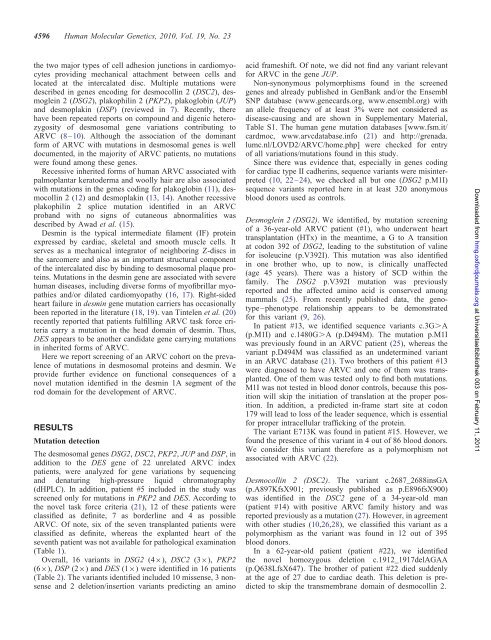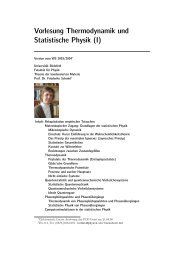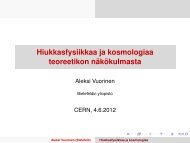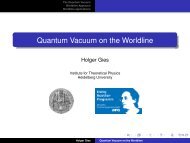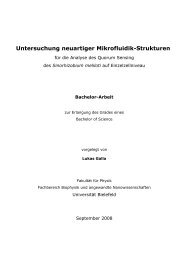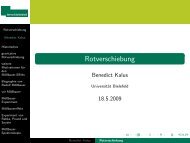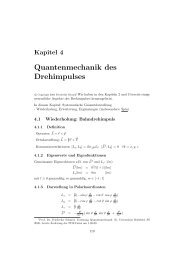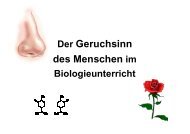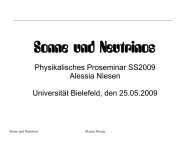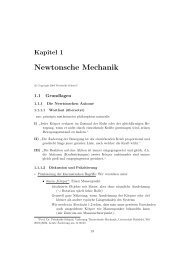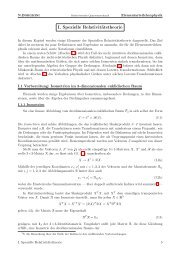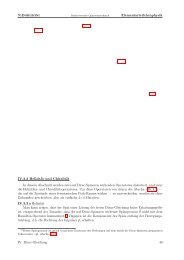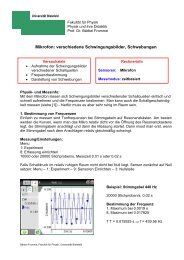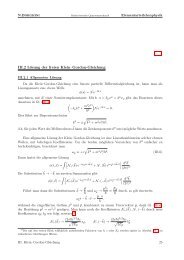De novo desmin-mutation N116S is associated with ... - ResearchGate
De novo desmin-mutation N116S is associated with ... - ResearchGate
De novo desmin-mutation N116S is associated with ... - ResearchGate
You also want an ePaper? Increase the reach of your titles
YUMPU automatically turns print PDFs into web optimized ePapers that Google loves.
4596 Human Molecular Genetics, 2010, Vol. 19, No. 23<br />
the two major types of cell adhesion junctions in cardiomyocytes<br />
providing mechanical attachment between cells and<br />
located at the intercalated d<strong>is</strong>c. Multiple <strong>mutation</strong>s were<br />
described in genes encoding for desmocollin 2 (DSC2), desmoglein<br />
2 (DSG2), plakophilin 2 (PKP2), plakoglobin (JUP)<br />
and desmoplakin (DSP) (reviewed in 7). Recently, there<br />
have been repeated reports on compound and digenic heterozygosity<br />
of desmosomal gene variations contributing to<br />
ARVC (8–10). Although the association of the dominant<br />
form of ARVC <strong>with</strong> <strong>mutation</strong>s in desmosomal genes <strong>is</strong> well<br />
documented, in the majority of ARVC patients, no <strong>mutation</strong>s<br />
were found among these genes.<br />
Recessive inherited forms of human ARVC <strong>associated</strong> <strong>with</strong><br />
palmoplantar keratoderma and woolly hair are also <strong>associated</strong><br />
<strong>with</strong> <strong>mutation</strong>s in the genes coding for plakoglobin (11), desmocollin<br />
2 (12) and desmoplakin (13, 14). Another recessive<br />
plakophilin 2 splice <strong>mutation</strong> identified in an ARVC<br />
proband <strong>with</strong> no signs of cutaneous abnormalities was<br />
described by Awad et al. (15).<br />
<strong>De</strong>smin <strong>is</strong> the typical intermediate filament (IF) protein<br />
expressed by cardiac, skeletal and smooth muscle cells. It<br />
serves as a mechanical integrator of neighboring Z-d<strong>is</strong>cs in<br />
the sarcomere and also as an important structural component<br />
of the intercalated d<strong>is</strong>c by binding to desmosomal plaque proteins.<br />
Mutations in the <strong>desmin</strong> gene are <strong>associated</strong> <strong>with</strong> severe<br />
human d<strong>is</strong>eases, including diverse forms of myofibrillar myopathies<br />
and/or dilated cardiomyopathy (16, 17). Right-sided<br />
heart failure in <strong>desmin</strong> gene <strong>mutation</strong> carriers has occasionally<br />
been reported in the literature (18, 19). van Tintelen et al. (20)<br />
recently reported that patients fulfilling ARVC task force criteria<br />
carry a <strong>mutation</strong> in the head domain of <strong>desmin</strong>. Thus,<br />
DES appears to be another candidate gene carrying <strong>mutation</strong>s<br />
in inherited forms of ARVC.<br />
Here we report screening of an ARVC cohort on the prevalence<br />
of <strong>mutation</strong>s in desmosomal proteins and <strong>desmin</strong>. We<br />
provide further evidence on functional consequences of a<br />
novel <strong>mutation</strong> identified in the <strong>desmin</strong> 1A segment of the<br />
rod domain for the development of ARVC.<br />
RESULTS<br />
Mutation detection<br />
The desmosomal genes DSG2, DSC2, PKP2, JUP and DSP, in<br />
addition to the DES gene of 22 unrelated ARVC index<br />
patients, were analyzed for gene variations by sequencing<br />
and denaturing high-pressure liquid chromatography<br />
(dHPLC). In addition, patient #5 included in the study was<br />
screened only for <strong>mutation</strong>s in PKP2 and DES. According to<br />
the novel task force criteria (21), 12 of these patients were<br />
classified as definite, 7 as borderline and 4 as possible<br />
ARVC. Of note, six of the seven transplanted patients were<br />
classified as definite, whereas the explanted heart of the<br />
seventh patient was not available for pathological examination<br />
(Table 1).<br />
Overall, 16 variants in DSG2 (4×), DSC2 (3×), PKP2<br />
(6×), DSP (2×) and DES (1×) were identified in 16 patients<br />
(Table 2). The variants identified included 10 m<strong>is</strong>sense, 3 nonsense<br />
and 2 deletion/insertion variants predicting an amino<br />
acid frameshift. Of note, we did not find any variant relevant<br />
for ARVC in the gene JUP.<br />
Non-synonymous polymorph<strong>is</strong>ms found in the screened<br />
genes and already publ<strong>is</strong>hed in GenBank and/or the Ensembl<br />
SNP database (www.genecards.org, www.ensembl.org) <strong>with</strong><br />
an allele frequency of at least 3% were not considered as<br />
d<strong>is</strong>ease-causing and are shown in Supplementary Material,<br />
Table S1. The human gene <strong>mutation</strong> databases [www.fsm.it/<br />
cardmoc, www.arvcdatabase.info (21) and http://grenada.<br />
lumc.nl/LOVD2/ARVC/home.php] were checked for entry<br />
of all variations/<strong>mutation</strong>s found in th<strong>is</strong> study.<br />
Since there was evidence that, especially in genes coding<br />
for cardiac type II cadherins, sequence variants were m<strong>is</strong>interpreted<br />
(10, 22–24), we checked all but one (DSG2 p.M1I)<br />
sequence variants reported here in at least 320 anonymous<br />
blood donors used as controls.<br />
<strong>De</strong>smoglein 2 (DSG2). We identified, by <strong>mutation</strong> screening<br />
of a 36-year-old ARVC patient (#1), who underwent heart<br />
transplantation (HTx) in the meantime, a G to A transition<br />
at codon 392 of DSG2, leading to the substitution of valine<br />
for <strong>is</strong>oleucine (p.V392I). Th<strong>is</strong> <strong>mutation</strong> was also identified<br />
in one brother who, up to now, <strong>is</strong> clinically unaffected<br />
(age 45 years). There was a h<strong>is</strong>tory of SCD <strong>with</strong>in the<br />
family. The DSG2 p.V392I <strong>mutation</strong> was previously<br />
reported and the affected amino acid <strong>is</strong> conserved among<br />
mammals (25). From recently publ<strong>is</strong>hed data, the genotype–phenotype<br />
relationship appears to be demonstrated<br />
for th<strong>is</strong> variant (9, 26).<br />
In patient #13, we identified sequence variants c.3G.A<br />
(p.M1I) and c.1480G.A (p.D494M). The <strong>mutation</strong> p.M1I<br />
was previously found in an ARVC patient (25), whereas the<br />
variant p.D494M was classified as an undetermined variant<br />
in an ARVC database (21). Two brothers of th<strong>is</strong> patient #13<br />
were diagnosed to have ARVC and one of them was transplanted.<br />
One of them was tested only to find both <strong>mutation</strong>s.<br />
M1I was not tested in blood donor controls, because th<strong>is</strong> position<br />
will skip the initiation of translation at the proper position.<br />
In addition, a predicted in-frame start site at codon<br />
179 will lead to loss of the leader sequence, which <strong>is</strong> essential<br />
for proper intracellular trafficking of the protein.<br />
The variant E713K was found in patient #15. However, we<br />
found the presence of th<strong>is</strong> variant in 4 out of 86 blood donors.<br />
We consider th<strong>is</strong> variant therefore as a polymorph<strong>is</strong>m not<br />
<strong>associated</strong> <strong>with</strong> ARVC (22).<br />
<strong>De</strong>smocollin 2 (DSC2). The variant c.2687_2688insGA<br />
(p.A897KfsX901; previously publ<strong>is</strong>hed as p.E896fsX900)<br />
was identified in the DSC2 gene of a 34-year-old man<br />
(patient #14) <strong>with</strong> positive ARVC family h<strong>is</strong>tory and was<br />
reported previously as a <strong>mutation</strong> (27). However, in agreement<br />
<strong>with</strong> other studies (10,26,28), we classified th<strong>is</strong> variant as a<br />
polymorph<strong>is</strong>m as the variant was found in 12 out of 395<br />
blood donors.<br />
In a 62-year-old patient (patient #22), we identified<br />
the novel homozygous deletion c.1912_1917delAGAA<br />
(p.Q638LfsX647). The brother of patient #22 died suddenly<br />
at the age of 27 due to cardiac death. Th<strong>is</strong> deletion <strong>is</strong> predicted<br />
to skip the transmembrane domain of desmocollin 2.<br />
Downloaded from<br />
hmg.oxfordjournals.org at Universitaetbibliothek 003 on February 11, 2011


